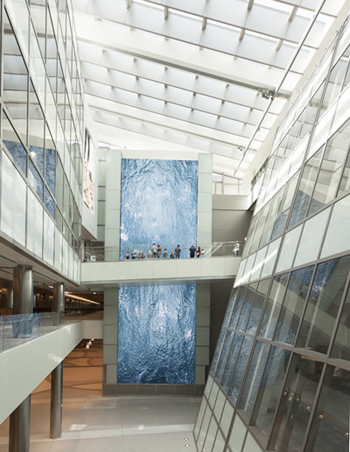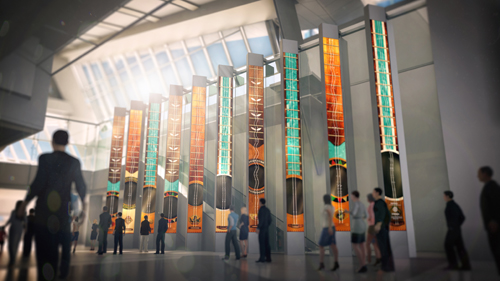LAX Unveils Content-Driven Digital Signage

This summer, crews completed the first phase of renovations to the Tom Bradley International Terminal at LAX airport in Los Angeles. The totally renovated 850,000 square-foot, three-story terminal—long overdue for a major revamp—now boasts one of the most impressive display technology configurations in the world. Well beyond “digital signage,” the multifaceted installation is the result of collaboration between some of the industry’s top players.
After a soft opening in mid-June, where the public was given a brief, one-day glimpse of the new terminal, LAX is preparing for an official opening in August. But the key player in content creation for the new digital display systems gave us a preview of the design and engineering behind the screens.
Moment Factory was commissioned by Los Angeles World Airports (LAWA) to work in collaboration with Marcela Sardi of Sardi Design and Mike Rubin of MRA International as the executive multimedia content producer for seven iconic media features at the terminal. The systems integrator was Electrosonic. Display technology and video processing manufacturers represented include Daktronics, Planar, Grass Valley, and Vista Spyder.
The result is the largest immersive multimedia system of any airport in the Americas. Moment Factory’s content focuses on the passenger experience, the iconography of Los Angeles, and the destinations served by the new terminal, creating four hours of original video content for the initial launch, as well as multiple interactive capsules using the latest in high-resolution imaging, and technologies that react directly to people’s movements and real-time airport information.
The overall objective of the media installation was “to enhance the passenger experience and bring back the romance and magic of travel.” While this sounds ambitious if not pretentious to the jaded international traveler, this is definitely not your father’s airport. And not your typical “digital signage” deployment in an airport, where stale ad-driven content and marginally useful wayfinding applications dominate.
“For us, it’s not just screens,” Marc-André Baril, Interactive Director at Moment Factory, told Digital Signage magazine. “We link everything together, in terms of content. So it’s not the ‘Times Square’ approach. The content is based on real-time data coming in from several sources. It’s this new approach, that lets us really recreate the excitement of travel.”
According to Moment Factory, the goal was create a visual adventure “that begins the moment passengers step into the New TBIT, harking back to a time when travel was exotic, whether flying to foreign shores or arriving in L.A.”
A daily selection of features, industry news, and analysis for tech managers. Sign up below.
The content really is different. It’s the kind of ambient content that avoids sales pitches, or overt pitches of any kind. Think atmosphere, and contextual content. For example, on the Destination Board, you might see a “Cloud Atlas” of ethereal content tied to nothing in particular but using lush, HD passages of flying through clouds. But when a flight for say, Tokyo, is near departure time, that content will change to scenes of Tokyo. Not selling something– just nice imagery that gets passengers out of airport mode and into destination mode.
A project on such a scale requires massive collaboration: the seven media features were designed by Sardi Design and MRA International. Fentress Architects designed the terminal and supported the media intervention and execution of the project. Smart Monkeys Inc. was the system designer and engineer. Electrosonic integrated the whole AV system. And Moment Factory was the executive content producer. (Also listed in the content creation “credits” for the project is Digital Kitchen. According to Marc-André Baril at Moment Factory, Digital Kitchen was tasked with a relatively small portion of the content creation, specifically to get another platform involved– as a way to be sure that any future content creators could easily adapt their approaches to the system, if need be.)
With its expertise in architectural media installations, immersive interactive installations and live event production around the world, Moment Factory sent film crews to three continents and worked creatively with dancers, actors and even parrots, turning the studio into a virtual tropical paradise. Over twelve months of work by the company’s team went into building the multimedia ecosystem, visualizing each animation via physical maquettes as well as 3D computer models, and adjusting all components to achieve seamless, engaging works of multimedia art and design.

The Time Tower, a 72-foot, four-sided functional clock tower built around the main elevators (you can actually enter into the elevator at the base of the Tower and ride to the 3rd floor) is completely clad with Daktronics 6mm LED screens that come alive with everything from an animal-packed jungle to an original tribute to the Hollywood silent-film era. The Time Tower also includes an interactive surface that reacts to the gestures of passengers by triggering customized, real-time visual effects. The base of the Time Tower uses Daktronics 10mm LED. This is the only display designed to be touched by anyone in the terminal.
“We put a diffusion glass in front of the 10mm LED at the base of the Time Tower, so you can’t see the pixels. There are IR sensors, that detect X and Y movement, at the base of the Tower. A person walking by can reach out and trigger stars that fly up the tower for example, so that people can lean out from the escalators and get the interactive result.”
The North and South Concourse Portals are two features composed of ten interactive 28-foot-tall columns made up of six Planar LCD panels each, continually change to reflect the movement of passengers as they walk by. Content to these displays is fed via Moment Factory’s proprietary X-Agora content distribution software. The images are scaled up to fill the tiled screens. Visuals and sound effects that continually change to reflect departing flights and the movement of passengers as they walk by. The Portals, with content evoking mosaic tiles, watery reflections, totem-like pillars and stringed instruments, suggest transformation and the movement. The content themes are inspired by LAX destinations such as Tokyo, Paris, Sydney and beyond.
The Welcome Wall is an 80-foot-tall Daktronics LED display of refreshing, lively images that greet passengers as they arrive in Los Angeles.
The Bon Voyage Wall, a feature designed for departing passengers, presents an array of slow-motion filmic images of people and places in Los Angeles, inspired by photographer Phillipe Halsman’s Jumpology series.
The Story Board, a 120-foot composition of multiple LED screens, displays visual narratives of Los Angeles, destination cities and the far corners of the Earth.
The Destination Board, a generative video “data cloud” displaying flight information and visual data on destination cities.
Moment Factory created over four hours of original video content (30+ original-content multimedia productions, or “capsules,” three to nine minutes in length).
The team also produced generative and interactive content: sixteen cities come to life on the Portals, with generative visuals and audio effects based on passengers’ movements and flights’ departure schedule; an interactive activation was produced for each of the 26 capsules on the Time Tower with real-time clocks and interactive touch effects at the base.
The Time Tower is the world’s largest interactive feature with an interactive base that triggers content across 6,480 square feet of Daktronics LED surfaces.
The total output of the IEMS is more than 105 million pixels (eight times an IMAX theater): That’s 19,075 square feet of video, enough to cover the length of the 81-story Eiffel Tower with a 6 meter wide display.
Moment Factory’s X-Agora software powers interactivity and generates dynamic real-time multimedia effects. Eight X-Agora servers and 20 X-Agora players run the interactive components of the IEMS.
Grass Valley K2 system is used for some content playback; Vista Spyder video processors used for mixing and matrixing.
Production techniques: documentary filming, time-lapse, ultra-high-speed filming in laboratory-like conditions, live-action shoots with actors and elaborate sets, on-location filming, pure 3D productions, 3D composited with live action, interactive real-time 3D and video effects, and more.
More than 300 people contributed their skills, including Moment Factory’s core team of over sixty multimedia artists, project managers and programmers.
More than 12 months of full-time work on conceptualization, design, production, post-production and a rigorous review and approval process, which called for presentations to LAX management and executives, the airport’s CEO, the Board of Airport Commissioners and the mayor.
Credits:
Client: Los Angeles World Airports (LAWA)
Project Director: MRA International
Feature designer / Creative Producer: Sardi Design
Architect: Fentress Architects
Systems Designer: Smart Monkeys
Executive Content Producer: Moment Factory
Content Producer: Digital Kitchen
Systems Engineer: Electrosonic
